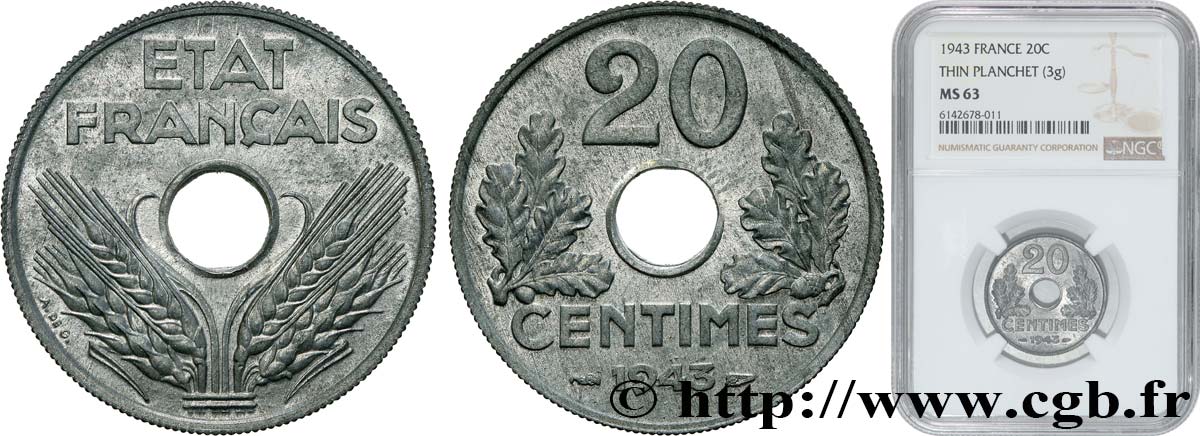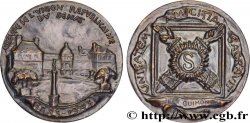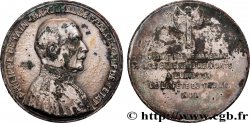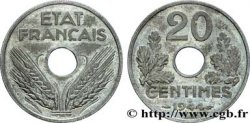Live auction - fmd_679066 - Pré-série sans le mot ESSAI de 20 centimes État français, légère, poids léger (2,88 g) 1943 F.153A/1 var.
得先注册又得到批准才可以报价。为了报价注册. 客户应该得到公司允许,那种过程需要 48 个小时。别等出售结束那一天才登记。您报价的话等于您赞成买那物品,而且按« 保价 » 证明您接受 cgb.fr 因特网拍卖使用法.
报价时只可以出全数值欧元总额。物品描述也说明销售结束时间,结束后出价都不会生效。 报价命令转达有时变动,等到最后秒钟增加否决的可能会。想多了解的话请注意 因特网拍卖常问
最高出价方将支付18%的不含税的拍卖费用
最高出价方将支付18%的不含税的拍卖费用
| 估算 : | 200 € |
| 价格 : | 116 € |
| 最高出价 : | 200 € |
| 拍卖结束日期 : | 05 September 2023 18:53:21 |
| 竞拍人 : | 3 竞拍人 |
种类 Pré-série sans le mot ESSAI de 20 centimes État français, légère, poids léger (2,88 g)
日期: 1943
铸币数量 ---
材质 zinc
直径 24 mm
模子方针 6 h.
重量 2,88 g.
侧面 cannelures fines
稀少度 R3
Slab

NGC : MS63
关于品相的说明
Sous coque NGC MS63, Thin Planchet
家谱
Cet exemplaire provient de la Collection Michel
正面
正面的文字 ETAT FRANÇAIS.
正面的说明书 Au-dessus d'épis posés sur un cartouche ; trou de perforation.
背面
背面的文字 20/ CENTIMES/ 1943.
背面的说明书 Entre deux branches de chêne.
评论
Toutes les 20 centimes État français contenues dans la Collection Michel ont pour point commun d’avoir une masse comprise aux alentours de 2.80 g. Par un effet du hasard (qui n'en est pas un) les exemplaires de la Collection PIERRE se situent à 3 g comme par exemple pour l'exemplaire suivant : https://www.cgb.fr/20-centimes-etat-francais-frappe-courante-1943-paris-f-153a-1-spl,v30_1159,a.html.
L'explication concernant les exemplaires de 2,8 g et de 3 g se trouve dans les archives de La Monnaie de Paris et à la page 832 de l'ouvrage “LE FRANC LES MONNAIES, LES ARCHIVES 2019” de Philippe Théret, le PV associé du 19 JUIN 1943 si situant en bas de page. L'alliage utilisé pour la réalisation des frappes est un zinc alu et il est précisé que les coins courants ont été utilisés (absence du mot essai). Les frappes ont donc été réalisées les 19 et 22 Juin 1943 sous la forme d'essais industriels (définition exacte d'une pré-série) sans le mot essai.
Le tirage réel est indiqué sur le PV:
- 3 g : 19 502 unités
- 2,8 g : 21 363 unités
Le modèle de 2,8 g n'ayant pas été retenu, l'ensemble du tirage a été cisaillé sauf 40 exemplaires et par conséquent un indice de rareté R3 est bien mérité pour l'ensemble des survivants. Le modèle de 3 g est donc de fait plus commun, la pré-série impossible à identifier par rapport au tirage normal qui a suivi.
Il est à noter que l'exemplaire actuellement en vente est lourd (2,88 g) pour un modèle 2,8 g mais la tolérance est large pour ce type (plus ou moins 5%) ce qui donne un modèle très léger jusqu'à 2,94 g. Le modèle léger de 3 g peut descendre jusqu'à 2,85 g. Ainsi le doute peut être permis pour cet exemplaire mais l'appartenance à la collection MICHEL peut permettre de le lever.
All the 20 centime French State coins contained in the Michel Collection have in common a mass of around 2. 80 g. By chance (which is not one) the examples of the PIERRE Collection are at 3 g as for example for the following example: https://www. cgb. fr/20-centimes-state-french-current-minted-1943-paris-f-153a-1-spl,v30_1159,a. html.
The explanation concerning the 2.8 g and 3 g examples can be found in the archives of La Monnaie de Paris and on page 832 of the work “LE FRANC LES MONNAIES, LES ARCHIVES 2019” by Philippe Théret, the associated PV of June 19, 1943 is located at the bottom of the page. The alloy used for the production of the strikes is zinc aluminum and it is specified that the standard dies were used (absence of the word test). The strikes were therefore carried out on June 19 and 22, 1943 in the form of industrial tests (exact definition of a pre-series) without the word test.
The actual mintage is indicated on the PV: - 3 g: 19,502 units - 2.8 g: 21,363 units The 2.8 g model not having been retained, the entire mintage was sheared except for 40 examples and consequently a rarity index R3 is well deserved for all the survivors. The 3g model is therefore in fact more common, the pre-series impossible to identify compared to the normal print run that followed.
It should be noted that the example currently on sale is heavy (2.88 g) for a 2.8 g model but the tolerance is wide for this type (plus or minus 5%) which gives a very light model up to 2.94 g. The lightweight 3g model can drop down to 2.85g. So doubt may be allowed for this example but the fact that it belongs to the MICHEL collection can help to remove it.
L'explication concernant les exemplaires de 2,8 g et de 3 g se trouve dans les archives de La Monnaie de Paris et à la page 832 de l'ouvrage “LE FRANC LES MONNAIES, LES ARCHIVES 2019” de Philippe Théret, le PV associé du 19 JUIN 1943 si situant en bas de page. L'alliage utilisé pour la réalisation des frappes est un zinc alu et il est précisé que les coins courants ont été utilisés (absence du mot essai). Les frappes ont donc été réalisées les 19 et 22 Juin 1943 sous la forme d'essais industriels (définition exacte d'une pré-série) sans le mot essai.
Le tirage réel est indiqué sur le PV:
- 3 g : 19 502 unités
- 2,8 g : 21 363 unités
Le modèle de 2,8 g n'ayant pas été retenu, l'ensemble du tirage a été cisaillé sauf 40 exemplaires et par conséquent un indice de rareté R3 est bien mérité pour l'ensemble des survivants. Le modèle de 3 g est donc de fait plus commun, la pré-série impossible à identifier par rapport au tirage normal qui a suivi.
Il est à noter que l'exemplaire actuellement en vente est lourd (2,88 g) pour un modèle 2,8 g mais la tolérance est large pour ce type (plus ou moins 5%) ce qui donne un modèle très léger jusqu'à 2,94 g. Le modèle léger de 3 g peut descendre jusqu'à 2,85 g. Ainsi le doute peut être permis pour cet exemplaire mais l'appartenance à la collection MICHEL peut permettre de le lever.
All the 20 centime French State coins contained in the Michel Collection have in common a mass of around 2. 80 g. By chance (which is not one) the examples of the PIERRE Collection are at 3 g as for example for the following example: https://www. cgb. fr/20-centimes-state-french-current-minted-1943-paris-f-153a-1-spl,v30_1159,a. html.
The explanation concerning the 2.8 g and 3 g examples can be found in the archives of La Monnaie de Paris and on page 832 of the work “LE FRANC LES MONNAIES, LES ARCHIVES 2019” by Philippe Théret, the associated PV of June 19, 1943 is located at the bottom of the page. The alloy used for the production of the strikes is zinc aluminum and it is specified that the standard dies were used (absence of the word test). The strikes were therefore carried out on June 19 and 22, 1943 in the form of industrial tests (exact definition of a pre-series) without the word test.
The actual mintage is indicated on the PV: - 3 g: 19,502 units - 2.8 g: 21,363 units The 2.8 g model not having been retained, the entire mintage was sheared except for 40 examples and consequently a rarity index R3 is well deserved for all the survivors. The 3g model is therefore in fact more common, the pre-series impossible to identify compared to the normal print run that followed.
It should be noted that the example currently on sale is heavy (2.88 g) for a 2.8 g model but the tolerance is wide for this type (plus or minus 5%) which gives a very light model up to 2.94 g. The lightweight 3g model can drop down to 2.85g. So doubt may be allowed for this example but the fact that it belongs to the MICHEL collection can help to remove it.








 对产品描述纠错
对产品描述纠错 打印
打印 分享我的选择
分享我的选择 提问
提问 Consign / sell
Consign / sell
 产品介绍
产品介绍















